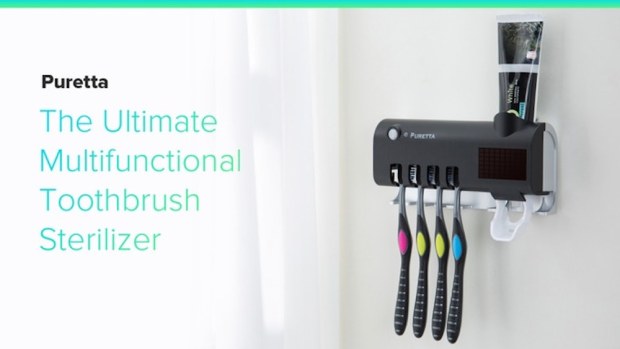Puretta And Disrupting The Toothbrush

Generally speaking, the merits of brushing teeth are not a hard sell for must humans and have not been for the last 5,000 or so years. Because yes, brushing one’s teeth is a shockingly old tradition.
The first “toothbrushes” appeared in 3,000 BCE, making the invention of proper oral hygiene roughly contemporary with the invention of written language. But the toothbrush 1.0 was a rather primitive design; it was mostly a stick with a frayed end that people chewed on to clean their teeth.
The next big update to the toothbrush came in 1498 in China, when bristles were added to the end of the brush. Those bristles came from the shaved neck hair of hogs, and they were pretty much the standard for the next 440 years or so, until 1938, when nylon bristles were introduced by Dupont. But the nylon, as opposed to board, bristle toothbrushes really didn’t catch on in the U.S. until after WWII, when returning GIs made oral hygiene cool among the general population and nylon toothbrushes saw widespread adoption.
Flash forward about 15 years and the toothbrush got its last major upgrade, the switch to electric care of Swiss inventor Philippe Guy Woog.
Since then toothbrushes have been somewhat inert.
Advertisements might tell one otherwise, new shaping that makes the head of the toothbrush 98 percent more effective (than something that is never specified; a different type of toothbrush; not brushing at all; sonar technology in an electric toothbrush that vibrates the plaque right off of teeth…. There are few forms of marketing more enthusiastic or ecstatic than the advertisements for various types of tooth cleaning devices. But the design, though improved or electrified, has mostly remained the same.
But new technology is changing the toothbrush, and possibly for the better. Some firms, for example, are working to make toothbrushes “smarter.” Featuring things like embedded AI, easy synching with mobile apps and 3D sensor technology so that the toothbrush can gather information on how one brushes, and even make helpful suggestions on how one might do it better or directly feed data back to dentists about how often and well one is cleaning one’s teeth.
Although that sounds good in theory, it does beg the question: Do consumers truly want judgy toothbrushes that are programmed to rat them out to their dentists?
Perhaps not, which is why the team at Puretta decided to see if there was a better way to use advanced technologies to improve the toothbrush. Ones that don’t involve making the toothbrush smart but do make it clean more effectively.
Because, as the founders noted, we tend to store out toothbrushes, which we put in our mouths to clean our teeth, in bathrooms, which are not generally the cleanest room in a consumer’s home. And toothbrushes, often left damp and ignored on the sides of sinks, are especially unclean, statistically speaking. A University of Manchester study indicates that the average toothbrush holds something like 10 million bacteria.
Puretta is a wall attachment that is a toothbrush holder, razor storage rack and toothpaste and floss dispenser designed to sterilize toothbrushes with UV light. It isn’t a plug-in. The system uses a solar panel for charging. The company says it can work in any indoor lighting environment, but it might help to have a bright bathroom.
The sterilization process is carried out with a 253.7 nm UV light. That figure is important because it is also known as a “germicidal light” or medical-grade UV light that reportedly kills 99.9 percent of bacteria from all angles. These types of lights are common, though generally not in home use. Labs tend to favor them as part of a water sterilization sequence. UV light in the 250 nm to 280 nm range works to activate microbial DNA in bacteria and viruses.
UV light also has known negative effects on human DNA, which means it’s best for people not to be exposed to it. Puretta works around that issue with an infrared motion sensor. When a human being is moving around in range of the device, the wall unit shuts itself off. When the room has gone still again the unit resumes its UV cleaning.
So how to buy this wonder of a product? Sadly, you can’t because this extremely early phase startup is still in the Kickstarter fundraising phase. But having exceeded its $10,000 goal by quite a lot – $43,319 – with nine days to go, it seems that at least getting to its next phase is assured.
But, as with all Kickstarter projects, even those with fancy prototype videos, the proof is in the shipping, when customer find out if their toothbrushes and razors are really cleaner as billed.
So stay tuned. The next great disruption of the toothbrush could soon be underway.
